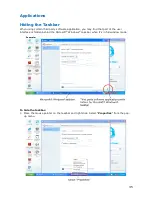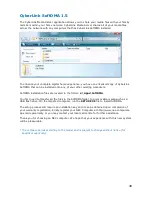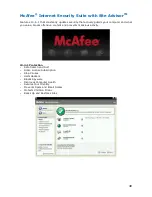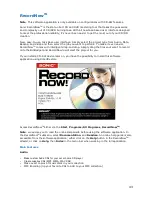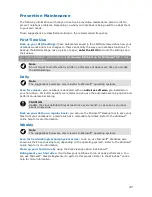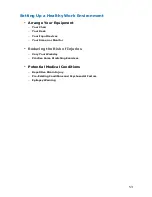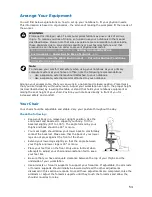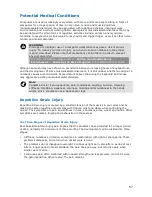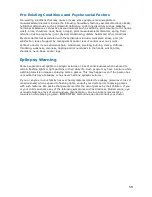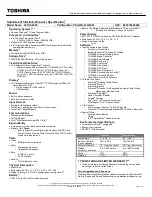
46
Operating Environment
Caring for your notebook also requires taking into account the effect of temperature, humidity,
and moisture on notebook components. Like any other electronic products, notebooks are
vulnerable to drastic changes in temperature, and especially moisture on notebook
components.
Please follow the tips below regarding the recommended operating environment:
•
Avoid using your notebook in high humidity
- computers are best used in moderate
humid conditions. Although notebooks are more sensitive to temperature than to humidity,
using a notebook in a humid environment can present problems especially when the
humidity reaches extreme levels. A few humid days are not really a cause for concern but
using, for instance, a laptop in a tropical jungle can present wear-out issues. Humidity
hastens corrosion and increases the risk of condensation that can damage certain parts.
Going directly from a cold to a warm environment leads to condensation. Cooling a
notebook is also difficult when humidity is high.
•
Before switching on, allow the notebook to adjust to room temperature
- in
general, electronic equipments that have been exposed or stored in very low temperatures
should adjust gradually to room temperature before they are switched on. Immediately
powering on a notebook that has been stored for some time at low temperatures in an
environment with high temperatures increases the risk of damaging parts.
•
Do not expose the notebook to moisture and spills
- users tend to stretch the limits
by using and leaving their notebooks at the most unlikely places like the kitchen, the
bathroom, on the garden table or by the swimming pool where the chances of it getting
wet is high. Placing a notebook near an open window is also not advisable since it can
easily collect and expose some parts to moisture. Be wary of liquid spilling into the power
supply since it may trigger an electric short-circuit.
•
Keep your notebook cool
- the key components in your notebook that require special
attention when it comes to cooling and proper ventilation are the power supply, the CPU,
the hard drive and the motherboard.
•
The fan in the power supply is designed not only to provide better airflow to the entire
case, but also to cool parts of the power supply that easily heat up.
•
CPUs are equipped with sophisticated heat sinks and fans to increase reliability and
prevent cooling-related problems like system lockups.
•
Fans do not directly cool the hard drive and components of the motherboard, but
provide better airflow to these parts. Cleaning the box and removing dust are beneficial
since accumulated dust can insulate the notebook making it difficult to cool the
notebook.
•
Ensure effective ventilation for your notebook
- even with sophisticated power supply
and CPU fans it is still important to install your notebook where there is good ventilation to
avoid overheating. Airflow, obviously, is more important in a warm room than in a cool
area. Pay attention to the obvious, such as providing space for the power supply fan to
blow freely and by not blocking the air vents that keep your notebook, monitor and other
devices from overheating. Good operating temperatures would be from 5
°
C to 35°C, and
cooler temperatures are generally better than higher temperatures.




